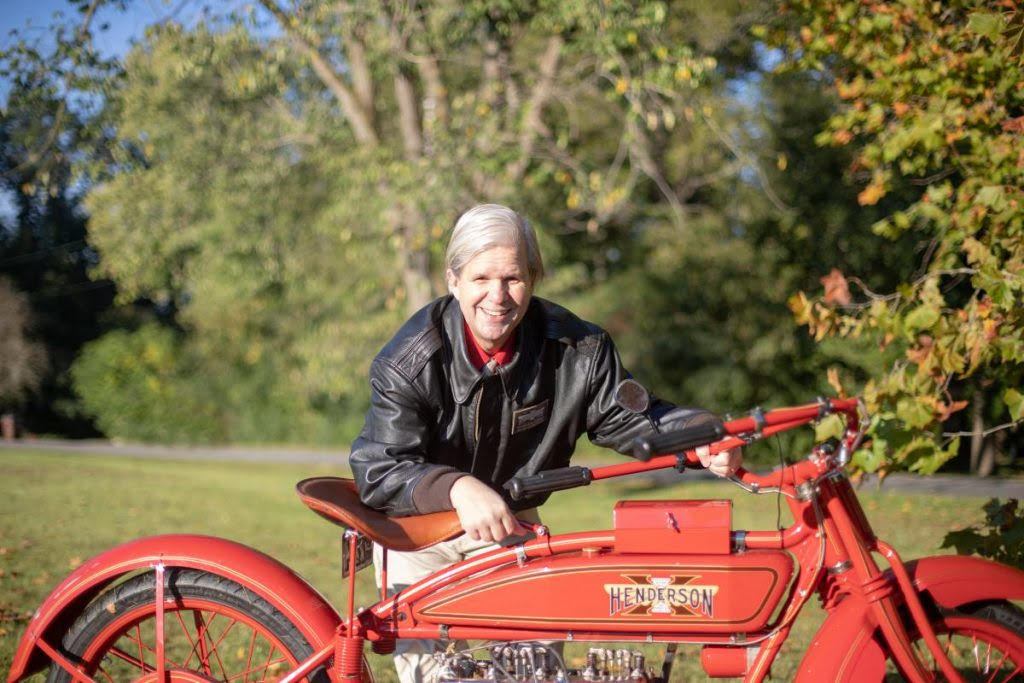Experience an Author’s Journey 4,500 miles Across America on a 100-Year-Old Henderson Motorcycle as Chronicled in New Book
In 1919, British Royal Air Force Captain Charles Kenilworth “C.K.” Shephard explored miles of territory on his trip across America on a 1919 Henderson motorcycle without the aid of GPS or knowledge of American roadways.
This summer, nearly 100 Years later United States Air Force Captain Mark Leslie Hunnibell retraces C.K.’s exact path with an epic journey from New York City to San Francisco covering nearly 4,500 miles across America on his own vintage four-speed 1919 Henderson motorcycle.
His fully annotated book, Across America by Motor-Cycleis a mammoth expedition book with more than 250 photos and illustrations of C.K.’s original journey coupled with Captain Hunnibell’s updated facts and explanations. It’s a stupendous motorcycle adventure travel book!
Buy the Book:
https://www.amazon.com/Across-America-Motor-Cycle-Mark-Hunnibell/dp/1948181495/ref=sr_1_1?crid=HG5NQ7BHS5R0&keywords=across+america+by+motor-cycle&qid=1560872977&s=gateway&sprefix=across+america%2Caps%2C142&sr=8-1
Follow Captain Hunnibell’s Journey:
https://acrossamericabymotorcycle.com/
Thanks for sitting down with me today Captain Mark L. Hunnibell to talk about your upcoming book and tour across America …
What is your book, Across America by Motor-Cycleabout?
The 1922 book, Across America by Motor-Cycle, is the story told by Captain C.K. Shepherd, a Royal Air Force (RAF) veteran of WWI from England who crossed America by motorcycle in 1919 after the war. In mid-June, within two weeks of arriving in Manhattan, C.K. bought a top-of-the-line Henderson four-cylinder motorcycle and was hot on the trail for California. In 1922, C.K.’s book was published, the story of his transcontinental journey in the summer of 1919 through sixteen states covering nearly 5,000 miles. C.K.’s story documents an amazing journey but regretfully did not include many details of the trip and the man who took it. This book answers them all.
What is your background?
In 1980, I received a Bachelor of Fine Arts Degree in Industrial Design from Rhode Island School of Design (RISD). A little over a year later, I joined the U.S. Air Force to be a pilot, where I served on active duty for seven years. Following that, I was hired as a pilot by American Airlines and retired in 2018 after almost 30 years.
Tell us about your own 1919 Henderson Motorcycle.
Near the end of my time at RISD, I saw the parts of an old motorcycle in my father’s machine shop at home. He told me the he had gotten the motorcycle from a friend who found it in India, heard that it had been bought new by the Nizam of Hyderabad VII. My father’s friend bought the pieces and had them shipped back. I expressed an interest in restoring it and my father gave it to me. Unfortunately, restoration was a huge undertaking that ended up lasting almost 40 years. But in 2018, it was running and back on the road for the first time in 60 years.
What made you so interested in C.K. Shepherd’s original book that you’d want to publish a fully annotated edition?
I discovered C.K.’s book about his 1919 trip some 20 years ago and was inspired by the epic journey on the same kind of motorcycle I owned and was ever-so-slowly restoring. I became consumed with the idea of retracing his journey, but the book lacked a detailed itinerary, leading me to complex research in order to reverse engineer the route. In the process, I discovered many details about C.K.’s ride and life that I thought many would appreciate even if they had never read the original book.
What are some fascinating aspects of C.K. Shepherd’s book?
Beyond the motorcycle riding itself, it is an outsider’s honest impressions of America as he saw it. It is laced with British use of words and terms, often with understated humor, and sometimes with a surprising result. For example, he wrote about his inability to get the hotel maid outside his room in Washington DC to tell him where the bathroom was. So, he said, he removed his “life preserver” from his pocket. “Its effect was magical” in that he was immediately shown to the bathroom. I did not understand what “life preserver” was until C.K.’s own son informed me that it was an old British term for revolver; C.K. pulled a gun on a maid so she would show him to the bathroom. Humorous indeed.
Do you suppose that C.K. Shepherd used maps to get across America back in 1919? Why do you think he picked the route he did?
There were not a large number of roadmaps for tourism by car back in 1919. One section of my book discusses the various maps and navigation options of the day, including the Official Automobile Blue Bookseries consisting of seven volumes each describing hundreds of routes, in turn-by-turn format, how to get from one place to another in various regions of the USA. C.K. did mention a visit to the AAA office on the 9thfloor of the Claypool Hotel in Indianapolis where they gave him their advice on the roads he could take to California, opining that the National Old Trails road was impassible to St. Louis, advice that C.K. took, because he went further south to Hannibal and onward to Kansas City and further west by the Old Santa Fe Trail. In the end, it seems C.K. took the roads he found most passable or at least in the best condition for his motorcycle journey. There which weren’t many such roads back in that day.

